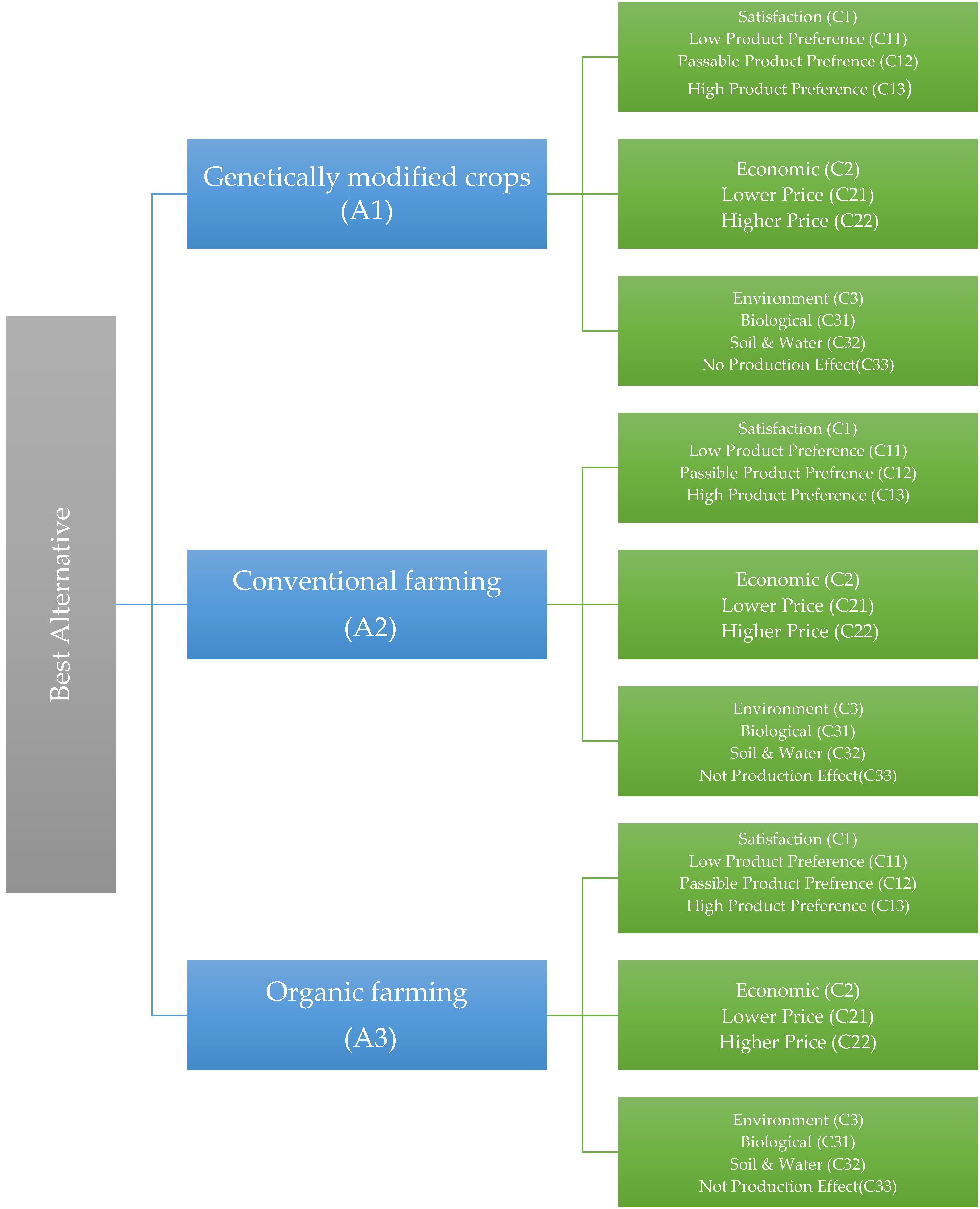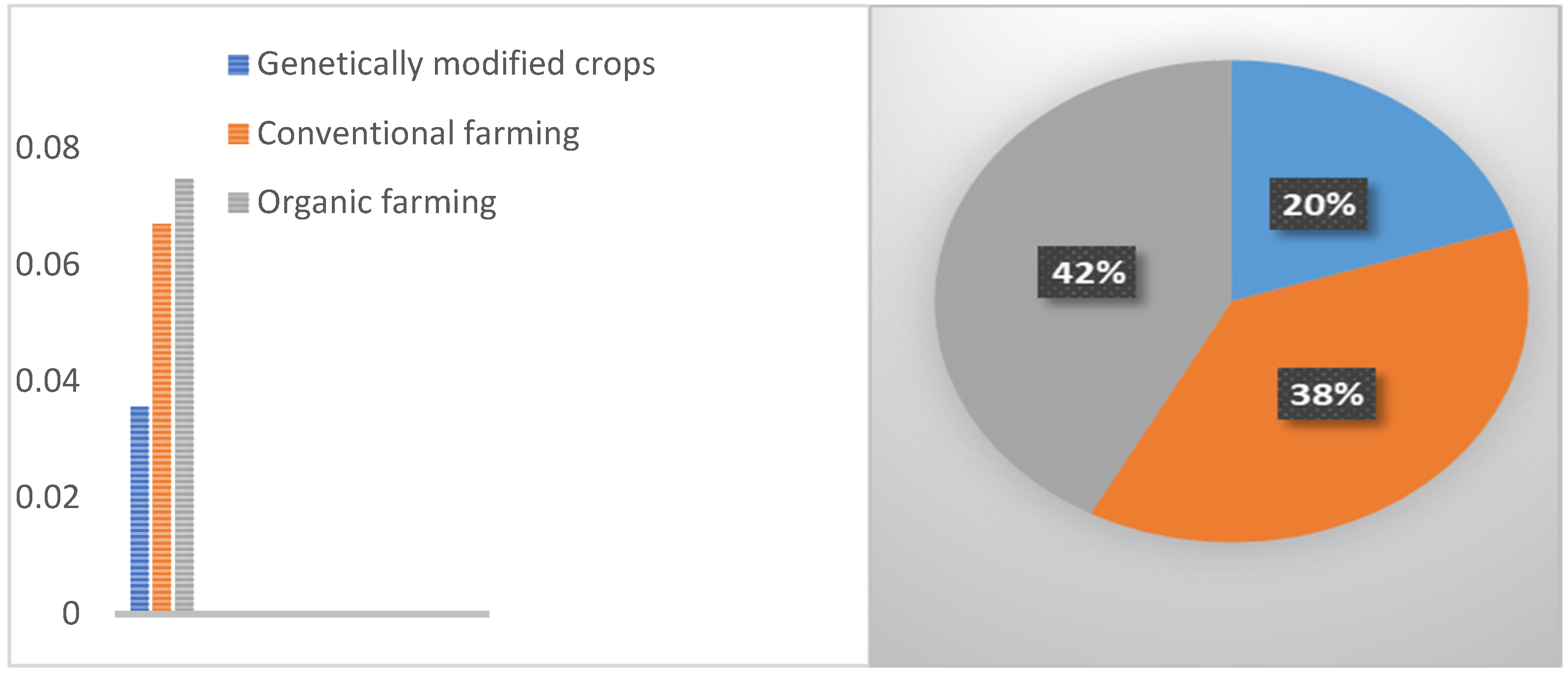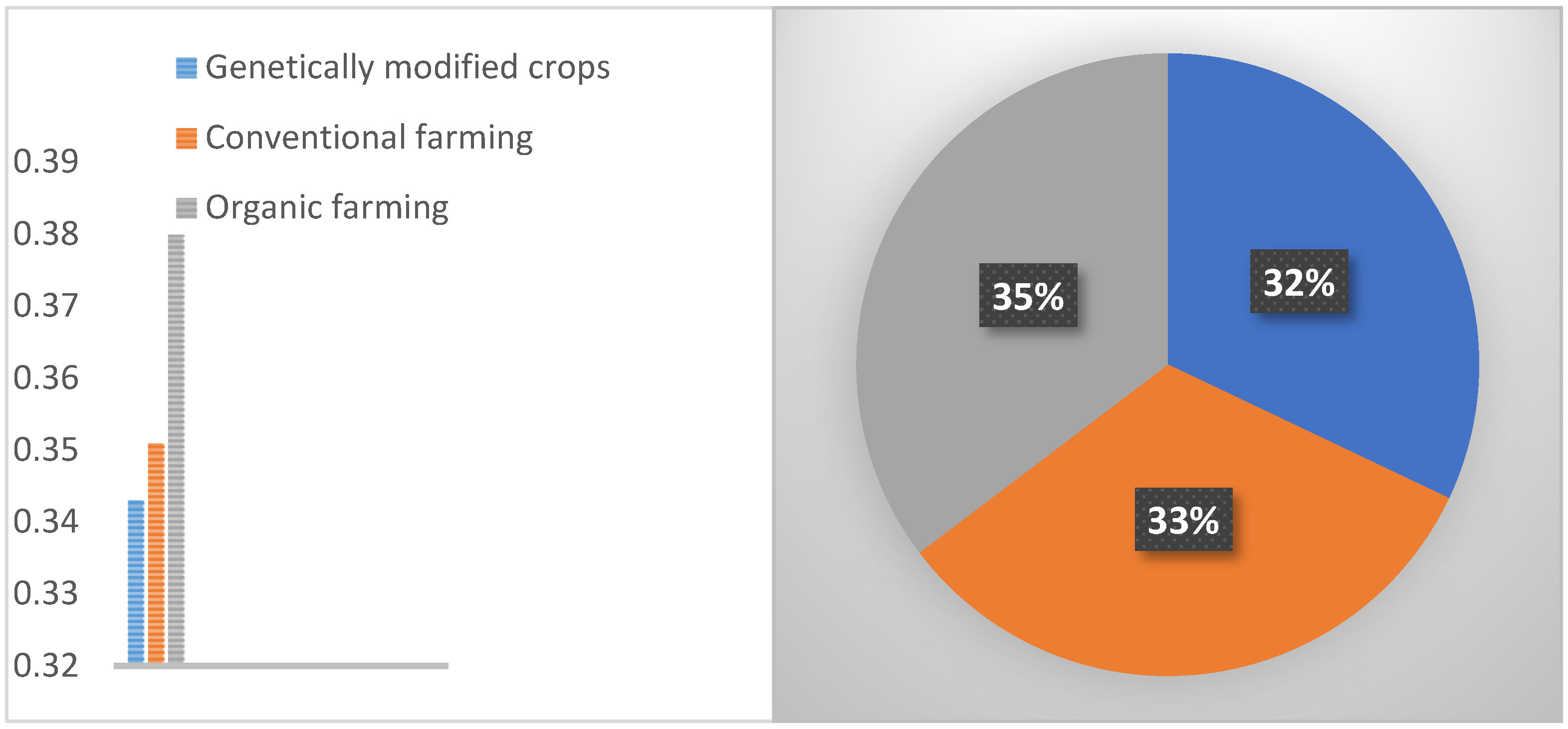An Integrated Fuzzy MCDM Hybrid Methodology to Analyze Agricultural Production
Abstract
:1. Introduction
2. Literature Review
- (i).
- What criteria have been chosen for evaluating the agricultural production technique determination process?
- (ii).
- What method(s) is (are) being employed to resolve the issue?
- (ii).
- What data types are considered input?
- (iv).
- What uncertainties are inherent considering the problem environment?
3. Methodology
3.1. FST
3.2. Fuzzy AHP
- Creating a tree structure with one aim, criteria, and solutions.
- Evaluating options by each criterion.
- Pairwise comparisons with subjective weighting factor computation
- Synthesis of results from stages 2 and 3 to compute total evaluation of options based on goal achievement.
- (1)
- examining the “criticalities” affecting the objectives in order to identify their relevance;
- (2)
- quantifying the importance of each objective in respect to the others; and
- (3)
- determining the objective weights [8].
3.3. Technique for Order of Preference by Similarity to Ideal Solution (TOPSIS)
3.4. Fuzzy TOPSIS
4. A Real Case Study
5. Results and Discussion
6. Conclusions
Author Contributions
Funding
Conflicts of Interest
References
- Fisher, M.R. Environmental Biology. Open Oregon Educatıonal Resources. 2021. Available online: https://openoregon.pressbooks.pub/envirobiology/chapter/9-3-conventional-agriculture/ (accessed on 1 September 2021).
- Takeda, S.; Matsuoka, M. Genetic approaches to crop improvement: Responding to environmental and population changes. Nat. Rev. Genet. 2008, 9, 444–457. [Google Scholar] [CrossRef] [PubMed]
- Mäder, P.; Fliessbach, A.; Dubois, D.; Gunst, L.; Fried, P.; Niggli, U. Soil fertility and biodiversity in organic farming. Science 2002, 296, 1694–1697. [Google Scholar] [CrossRef] [PubMed] [Green Version]
- Tuomisto, H.L.; Hodge, I.D.; Riordan, P.; Macdonald, D.W. Does organic farming reduce environmental impacts—A meta-analysis of European research. J. Environ. Manag. 2012, 112, 309–320. [Google Scholar] [CrossRef] [PubMed]
- Jordan, R.; Müller, A.; Oudes, A. High Sequestration, Low Emission, Food Secure Farming. Organic Agriculture—A Guide to Climate Change and Food Security; International Federation of Organic Agriculture Movements (IFOAM)/IFOAM EUGroup: Brussels, Belgium; Bonn, Germany, 2009. [Google Scholar]
- Alossta, A.; Elmansouri, O.; Badi, I. Resolving a location selection problem by means of an integrated AHP-RAFSI approach. Rep. Mech. Eng. 2021, 2, 135–142. [Google Scholar] [CrossRef]
- Wudhikarn, R.; Chakpitak, N.; Neubert, G. Use of an analytic network process and monte carlo analysis in new product formula selection decisions. Asia-Pac. J. Oper. Res. 2015, 32, 1550007. [Google Scholar] [CrossRef]
- Shanshan, Z.; Yu, G.; Shaohua, H.; Pengzhou, T. A Hybrid MCDM Approach Based on ANP and TOPSIS for Facility Layout Selection. Trans. Nanjing Univ. Aeronaut. Astronaut. 2018, 35, 1027–1037. [Google Scholar]
- Wudhikarn, R. Improving the intellectual capital management approach using the hybrid decision method. J. Intellect. Cap. 2018, 19, 670–691. [Google Scholar] [CrossRef]
- Mosadeghia, R.; Warnkenb, J.; Tomlinsona, R.; Mirfenderesk, H. Uncertainty analysis in the application of multi-criteria decision-making methods in Australian strategic environmental decisions. J. Environ. Plan. Manag. 2013, 56, 1097–1124. [Google Scholar] [CrossRef] [Green Version]
- Sarper, A. Special Agriculture Production Selection Using Interval Type-2 Fuzzy AHP. In Intelligent and Fuzzy Techniques: Smart and Innovative Solutions, Proceedings of the INFUS 2020 Conference, Istanbul, Turkey, 21–23 July 2020; Advances in Intelligent Systems and Computing Book Series; Springer: Cham, Switzerland, 2020; Volume 1197. [Google Scholar]
- Zandi, P.; Rahmani, M.; Khanian, M.; Mosavi, A. Agricultural Risk Management Using Fuzzy TOPSIS Analytical Hierarchy Process (AHP) and Failure Mode and Effects Analysis (FMEA). Agriculture 2020, 10, 504. [Google Scholar] [CrossRef]
- Ren, C.; Li, Z.; Zhang, H. Integrated multi-objective stochastic fuzzy programming and AHP method for agricultural water and land optimization allocation under multiple uncertainties. J. Clean. Prod. 2018, 210, 12–24. [Google Scholar] [CrossRef]
- Pilevar, A.R.; Matinfara, H.R.; Sohrabia, A.; Sarmadianb, F. Integrated fuzzy, AHP and GIS techniques for land suitability assessment in semi-arid regions for wheat and maize farming. Ecol. Indic. 2020, 110, 105887. [Google Scholar] [CrossRef]
- Firdaus, A.; Adiprasetyo, T.; Suhartoyo, H. A Multicriteria Decision Making and Fuzzy-AHP Approach for Formulating Strategy to Develop Organic Agriculture in Bengkulu Province Indonesia. Adv. Biol. Sci. Res. 2021, 13, 213–218. [Google Scholar] [CrossRef]
- Tashayo, B.; Honarbakhsh, A.; Azma, A.A.; Akbari, M. Combined Fuzzy AHP–GIS for Agricultural Land Suitability Modeling for a Watershed in Southern Iran. Environ. Manag. 2020, 66, 364–376. [Google Scholar] [CrossRef] [PubMed]
- Mohammadrezaei, N.; Pazira, E.; Sokoti, R.; Ahmadi, A. Land Suitability Evaluation for Wheat Cultivation by Fuzzy-AHP, Fuzzy-Simul Theory Approach as Compared with Parametric Method in the Southern Plain of Urmia. Bull. Environ. Pharmacol. Life Sci. 2014, 3, 112–117. [Google Scholar]
- Rahimabadi, D.P.; Azarnivand, H.; Khosravi, H.; Zehtabian, G.; Nia, M.A. An ecological agricultural model using fuzzy AHP and PROMETHEE II approach. Desert 2021, 26, 71–83. [Google Scholar] [CrossRef]
- Demirel, N.Ç.; Nilay, G.; Yucenur, Y.; Demirel, T.; Musdal, H. Risk-Based Evaluation of Turkish AgriculturalStrategies using Fuzzy AHP and Fuzzy ANP. Hum. Ecol. Risk Assess. 2012, 18, 685–702. [Google Scholar] [CrossRef]
- Rouyendegh, B.D. Developing an integrated AHP and intuitionistic fuzzy TOPSIS methodology. Tech. Gaz. 2014, 21, 1313–1319. [Google Scholar]
- Qureshi, M.N.; Pradeep, K.; Dinesh, K. Framework for benchmarking logistics performance using fuzzy AHP, International Journal of Business Performance. Supply Chain. Model 2009, 1, 82–98. [Google Scholar]
- Kahraman, Ç.; Ruan, D.; Doğan, I. Fuzzy group decision-making for facility location selection. Inf. Sci. 2003, 157, 135–153. [Google Scholar] [CrossRef]
- Kahraman, Ç.; Ruan, D.; Ethem, T. Capital budgeting techniques using discounted fuzzy versus probabilistic cash flows. Inf. Sci. 2002, 42, 57–76. [Google Scholar] [CrossRef]
- Kontodimopoulos, N.; Niakas, D. A 12-year analysis of Malmquist total factor productivity in dialysis facilities. J. Med. Syst. 2006, 30, 333–342. [Google Scholar] [CrossRef] [PubMed]
- Gaudenzi, B.; Borghesi, A. Managing risks in the supply chain using the AHP method. Int. J. Logist. Manag. 2006, 17, 114–136. [Google Scholar] [CrossRef]
- Caglayan, N.; Yildizbasi, A.; Rouyendegh, B.D. Fuzzy AHP Approach to Prioritizing the Critical Success Factors of Organizational Culture. Int. J. Organ. Leadersh. 2018, 7, 454–466. Available online: https://ssrn.com/abstract=3337637 (accessed on 1 September 2021). [CrossRef]
- Bakır, M.; Atalık, Ö. Application of fuzzy AHP and fuzzy MARCOS approach for the evaluation of e-service quality in the airline industry. Decis. Mak. Appl. Manag. Eng. 2021, 4, 127–152. [Google Scholar] [CrossRef]
- Rouyendegh, B.D.; Topuz, K.; Dag, A.; Oztekin, A. An AHP-IFT Integrated Model for Performance Evaluation of E-Commerce Web Sites. Inf. Syst. Front. 2018, 21, 1345–1355. [Google Scholar] [CrossRef]
- Naseem, M.H.; Yang, J.; Xiang, Z. Prioritizing the Solutions to Reverse Logistics Barriers for the E-Commerce Industry in Pakistan Based on a Fuzzy AHP-TOPSIS Approach. Sustainability 2021, 13, 12743. [Google Scholar] [CrossRef]
- Wang, Y.M.; Elhag, T.M.S. Fuzzy TOPSIS method based on alpha level sets with an application to bridge risk assessment. Exp. Syst. App. 2006, 31, 309–319. [Google Scholar] [CrossRef]
- Rouyendegh, B.D.; Saputro, T.E. Supplier selection using integrated fuzzy TOPSIS and MCGP: A case study. Procedia—Soc. Behav. Sci. 2011, 116, 3957–3970. [Google Scholar] [CrossRef] [Green Version]
- Carlsson, C. Fuzzy multiple criteria decision making: Recent developments. Fuzzy Sets Syst. 1996, 78, 139–153. [Google Scholar] [CrossRef] [Green Version]
- Nouri, F.A.; Esbouei, S.K.; Antucheviciene, J. A hybrid mcdm approach based on fuzzy ANP and fuzzy TOPSIS for technology selection. Informatıca 2015, 26, 369–388. [Google Scholar] [CrossRef] [Green Version]
- Piya, S.; Shamsuzzoha, A.; Azizuddin, M.; Al-Hinai, N.; Erdebilli, B. Integrated Fuzzy AHP-TOPSIS Method to Analyze Green Management Practice in Hospitality Industry in the Sultanate of Oman. Sustainability 2022, 14, 1118. [Google Scholar] [CrossRef]
- ISAAA 2013 Annual Report. ISAAA Brief 46-2013. 2013. Retrieved 6 August 2014. Executive Summary, Global Status of Commercialized Biotech/GM Crops, Hurt, The Green Revolution in the Global South, p. 161. Available online: https://www.appropedia.org/Conventional_farming#cite_note-1 (accessed on 31 March 2022).
- Paull, J. Organic Agriculture in Australia: Attaining the Global Majority (51%). J. Environ. Prot. Sustain. Dev. 2019, 5, 70–74. [Google Scholar]
- USDA Blog. Organic 101: Allowed and Prohibited Substances. Retrieved 6 April 2016. Available online: Blogs.usda.gov (accessed on 1 September 2021).
- Treadwell, D.; Riddle, J.; Barbercheck, M.; Cavanaugh-Grant, D.; Zaborski, E. Cooperative Extension System, What Is Organic Farming? Archived 3 May 2016 at the Wayback Machine. Available online: https://eorganic.org/node/3498 (accessed on 1 September 2021).
- Wudhikarn, R.; Chakpitak, N.; Neub, G. Improving the Strategic Benchmarking of Intellectual Capital Management in Logistics Service Providers. Sustainability 2020, 12, 10174. [Google Scholar] [CrossRef]




| Author (Year) | Title | AHP | Fuzzy AHP | Interval Type-2 Fuzzy AHP | Fuzzy ANP | Fuzzy TOPSIS | PROMETHEE II |
|---|---|---|---|---|---|---|---|
| Sarper Alem (2020) | Special Agriculture Production Selection Using Interval Type-2 Fuzzy AHP | √ | |||||
| Zandi et al. (2020) | Agricultural Risk Management Using Fuzzy TOPSIS Analytical Hierarchy Process (AHP) and Failure Mode and Effects Analysis (FMEA) Agriculture | √ | √ | ||||
| Ren et al. (2018) | Integrated multi-objective stochastic fuzzy programming and AHP method for agricultural water and land optimization allocation under multiple uncertainties, Journal of Cleaner Production | √ | |||||
| Pilevar et al. (2019) | Integrated fuzzy, AHP and GIS techniques for land suitability assessment in semi-arid regions for wheat and maize farming Ecological Indicators | √ | |||||
| Firdaus et al. (2020) | A Multicriteria Decision Making and Fuzzy-AHP Approach for Formulating Strategy to Develop Organic Agriculture in Bengkulu Province, Indonesia | √ | |||||
| Tashayo et al. (2020) | Combined Fuzzy AHP–GIS for Agricultural Land Suitability Modeling for a Watershed in Southern Iran | √ | |||||
| Mohammad Rezaei et al. (2014) | Land Suitability Evaluation for Wheat Cultivation by Fuzzy-AHP, Fuzzy-Simul Theory Approach as Compared with Parametric Method in the Southern Plain of Urmia | √ | |||||
| Rahimabadi et al. (2021) | An ecological agricultural model using fuzzy AHP and PROMETHEE II approach | √ | √ | ||||
| Demirel et al. (2012) | Risk-Based Evaluation of Turkish Agricultural Strategies using Fuzzy AHP and Fuzzy ANP | √ | √ |
| Linguistic Terms | Triangular Fuzzy Scale | Triangular Fuzzy Reciprocal Scale |
|---|---|---|
| Same Importance (SI) | (1, 1, 1) | (1/1, 1/1, 1/1) |
| Moderate Importance (MI) | (1, 3, 5) | (1/5, 1/3, 1/1) |
| Demonstrated Importance (DI) | (5, 7, 9) | (1/9, 1/7, 1/5) |
| Extreme Importance (EI) | (7, 9, 9) | (1/9, 1/9, 1/7) |
| Alternative Name | Explanation |
|---|---|
| Genetically modified crops (GM crops) (A1) | Genetically modified crops (GM crops) are agricultural plants whose DNA has been altered by genetic engineering. Plant genomes can be modified physically or by Agrobacterium delivering sequences in T-DNA binary vectors. In most cases, the goal is to give the plant a new trait that it does not have naturally. Examples in food crops include insect, disease, and environmental resistance; spoilage reduction; chemical resistance (e.g., herbicide resistance); and improved nutrient profile. Among the non-food crops are pharmaceuticals, biodiesel, and other industrial items, along with bioremediation [35]. |
| Conventional farming (A2) | Conventional farming practices: Intensive animal feeding operations, high irrigation, intensive tillage, and monoculture farming are examples of conventional farming practices. Because of this, conventional agriculture uses a lot of resources. Contrary to popular assumption, conventional agriculture dates from the early 1900s [36]. |
| Organic farming (A3) | Organic farming practices include the use of compost manure, green manure, and bone meal as fertilizers. A response to rapidly changing farming practices, it began in the early twentieth century. Globally, certified organic agriculture occupies 70 million hectares, with Australia accounting for over 50%. Diverse groups are still working on organic farming. The use of insect predators and varied cropping is advised. Organic standards allow natural compounds while forbidding or severely regulating manufactured substances [37,38]. |
| Criteria | Explanation |
|---|---|
| Satisfaction (C1) | In general, marketing frequently makes use of satisfaction. This measure shows how a company’s products meet or exceed customer expectations. |
| Economic (C2) | Economic impact is concerned about the financial impact of a new development on a situation or individual. Economic creation explores the influence of agricultural production techniques on pricing rates. |
| Environment (C3) | The term “environment” includes all naturally occurring living and non-living things. The environment is described as the interplay of all living things, their climate, weather, and natural resources, which affects human survival and economic activity. Additionally, it is referred to as the natural environment. |
| Matrix in Linguistic Terms | Matrix in Fuzzy Terms | |||||
|---|---|---|---|---|---|---|
| C1 | C2 | C3 | C1 | C2 | C3 | |
| C1 | * | MH | (1, 1, 1) | (3, 5, 7) | (1/9, 1/7, 1/5) | |
| C2 | * | (1/7, 1/5, 1/3) | (1, 1, 1) | (1/9, 1/7, 1/5) | ||
| C3 | H | H | * | (5, 7, 9) | (5, 7, 9) | (1, 1, 1) |
| Matrix in linguistic terms | Matrix in fuzzy terms | |||||
| C1 | A1 | A2 | A3 | A1 | A2 | A3 |
| A1 | * | MH | (1, 1, 1) | (1/9, 1/7, 7) | (3, 5, 7) | |
| A2 | H | * | H | (5, 7, 9) | (1, 1, 1) | (5, 7, 9) |
| A3 | * | (1/7, 1/5, 1/3) | (1/9, 1/7, 1/5) | (1, 1, 1) | ||
| Matrix in linguistic terms | Matrix in fuzzy terms | |||||
| C2 | A1 | A2 | A3 | A1 | A2 | A3 |
| A1 | * | MH | (1, 1, 1) | (1/9, 1/7, 1/5) | (3, 5, 7) | |
| A2 | H | * | H | (5, 7, 9) | (1, 1, 1) | (5, 7, 9) |
| A3 | * | (1/7, 1/5, 1/3) | (1/9, 1/7, 1/5) | (1, 1, 1) | ||
| Matrix in linguistic terms | Matrix in fuzzy terms | |||||
| C3 | A1 | A2 | A3 | A1 | A2 | A3 |
| A1 | * | MH | (1, 1, 1) | (3, 5, 7) | (1/9, 1/7, 1/5) | |
| A2 | * | H | (1/7, 1/5, 1/3) | (1, 1, 1) | (5, 7, 9) | |
| A3 | H | * | (5, 7, 9) | (1/9, 1/7, 1/5) | (1, 1, 1) | |
| Alternatives | |
|---|---|
| A1 | 0.035656 |
| A2 | 0.067087 |
| A3 | 0.074816 |
| Alternatives | |
|---|---|
| A1 | 0.343 |
| A2 | 0.351 |
| A3 | 0.380 |
Publisher’s Note: MDPI stays neutral with regard to jurisdictional claims in published maps and institutional affiliations. |
© 2022 by the authors. Licensee MDPI, Basel, Switzerland. This article is an open access article distributed under the terms and conditions of the Creative Commons Attribution (CC BY) license (https://creativecommons.org/licenses/by/4.0/).
Share and Cite
Rouyendegh, B.D.; Savalan, Ş. An Integrated Fuzzy MCDM Hybrid Methodology to Analyze Agricultural Production. Sustainability 2022, 14, 4835. https://doi.org/10.3390/su14084835
Rouyendegh BD, Savalan Ş. An Integrated Fuzzy MCDM Hybrid Methodology to Analyze Agricultural Production. Sustainability. 2022; 14(8):4835. https://doi.org/10.3390/su14084835
Chicago/Turabian StyleRouyendegh, Babak Daneshvar, and Şeyda Savalan. 2022. "An Integrated Fuzzy MCDM Hybrid Methodology to Analyze Agricultural Production" Sustainability 14, no. 8: 4835. https://doi.org/10.3390/su14084835
APA StyleRouyendegh, B. D., & Savalan, Ş. (2022). An Integrated Fuzzy MCDM Hybrid Methodology to Analyze Agricultural Production. Sustainability, 14(8), 4835. https://doi.org/10.3390/su14084835



.jpg)



